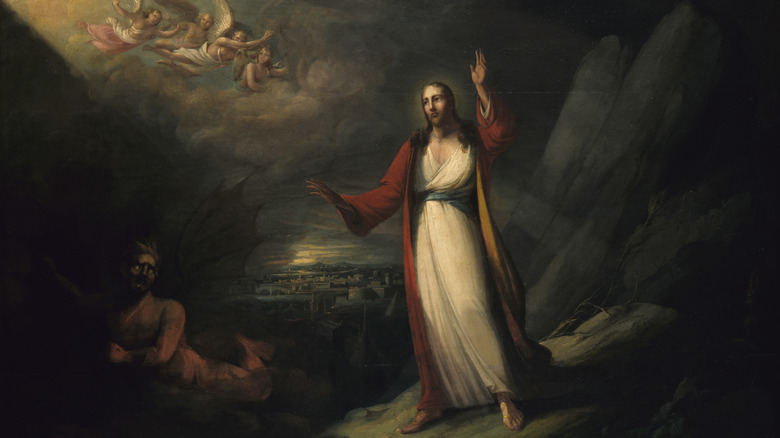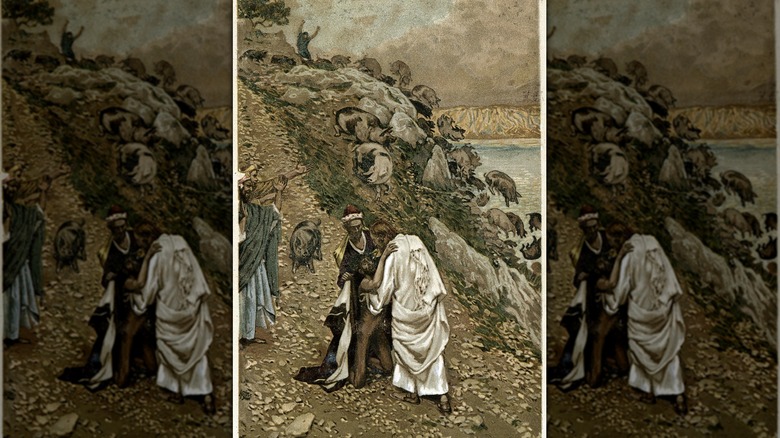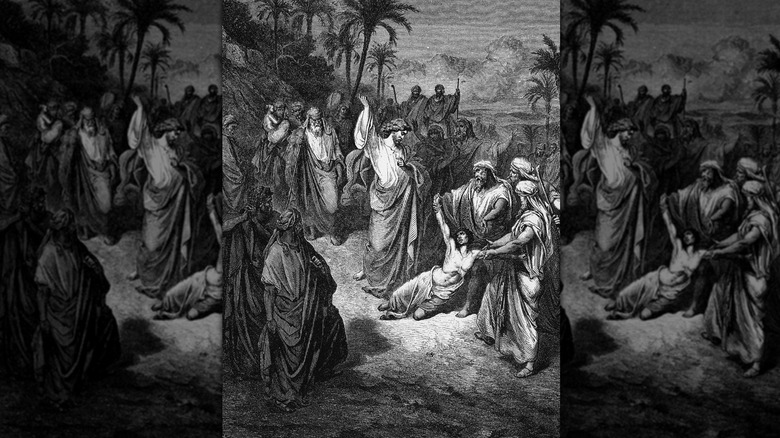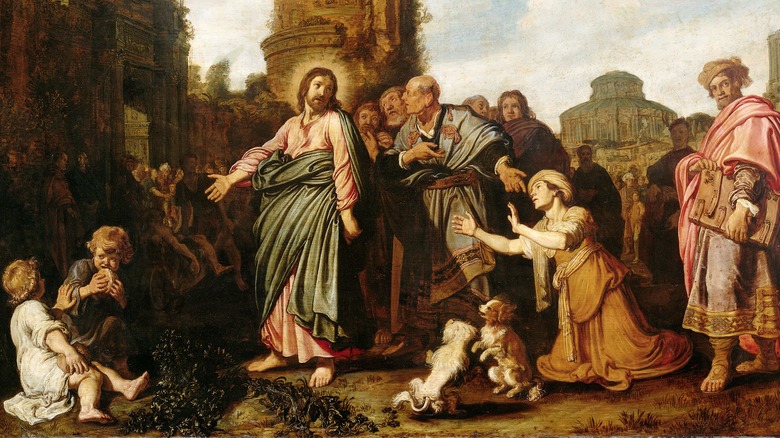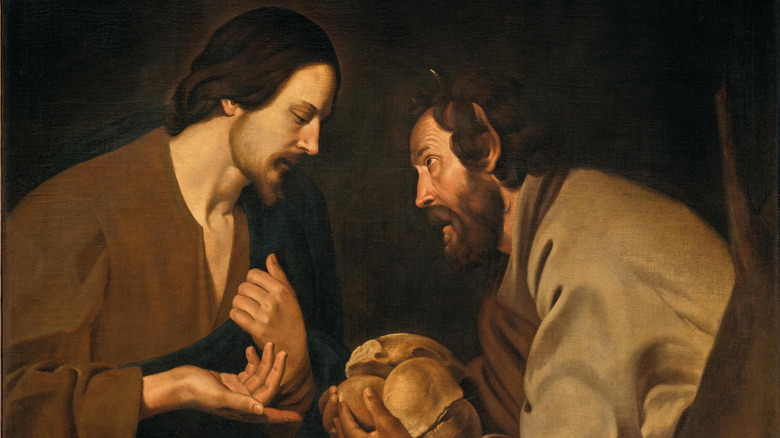The Most Disturbing Demons Jesus Confronted In The Bible
In "The Exorcist," the doctors who recommend that Regan MacNeil undergo an exorcism describe the ritual as "an embarrassment," only held onto by the Catholics. But the casting out of demons and wicked spirits is hardly some covert, half-denied practice in the Bible. Possession, hauntings, and temptations run throughout its books, and various heroes, prophets, and saints confront the supernatural in the Old and New Testaments. Among the most prominent of the exorcists? Jesus Christ.
Jesus has several confirmed or implied encounters with demons across three gospels, Matthew, Luke, and Mark. But many of these episodes are only briefly touched on; in Mark 1:32, for instance (via Bible Gateway), treats the curing of many people possessed by demons as what might be called a throwaway miracle (the same incident is repeated in Matthew and Luke in similarly scant detail). Mark 1:39 only spends a single sentence on a case of mass exorcism. In only a handful of the encounters between Jesus and demons is he shown to cast out those demons in any detail.
Those episodes can read as early prototypes of the kinds of possession stories we know best today through films such as "The Exorcist." Others might come off as slightly comical in the 21st century but would have been taken in deadly earnest in times past. Here are Jesus's most fleshed-out exorcisms of demons and unclean spirits.
A spirit confronts Jesus at the Capernaum Synagogue
Mark 1 and Luke 4 both tell the story of how when Jesus came to Galilee, Jesus set himself up in the synagogue of the town of Capernaum and taught there on the Sabbath. He was doing well, impressing the people with the force of his instruction, when a man of the synagogue came forth to confront Jesus. This man was possessed by what Mark refers to only as an "unclean spirit" and Luke calls both a spirit and a demon.
The demon performed no violence and claimed no lives or souls. In both gospels, he asked Jesus: "What do you want with us, Jesus of Nazareth? Have you come to destroy us? I know who you are — the Holy One of God!" To this concern, Jesus commanded the spirit to come out of the man and leave him be. In Mark, the demon cast down his mortal vessel and fled "with a shriek." In Luke, the demon leaves silently. Both gospels agree that the demon did the man no harm. But this display of power over spirits only enhanced Jesus's reputation among the people, and the story was quickly spread throughout Galilee.
Legion was cast into the pigs
One of the most elaborate stories of demonic possession and exorcism in the New Testament appears in three of the gospels, Matthew, Mark, and Luke, though the latter two books go into greater detail and differ in key aspects from Matthew. In all three accounts, the story goes that after taking a boat across a lake Jesus found himself in a region that has been translated as the Gadarenes and the Gerasenes. There, Jesus found what in Matthew is described as two men possessed by demons emerging from a tomb. The spirits within them were so violent that they barred all from crossing. In Mark and Luke, there was only one man whom his fellow villagers had tried to keep bound in chains, but the demon within broke the chains, carried the man into the tombs, and (in Mark) cut him on the stones.
In Mark, when Jesus asked the demon its name, it replied, "Legion...for we are many." In Mark and Luke, the legions begged Jesus not to torture them; they feared the eternal abyss in Luke. Matthew presents the demons in its two men as more contemptuous and defiant. But all the gospels agree that when they sighted a nearby herd of pigs the demons asked Jesus to let them possess the swine, and Jesus commanded them to go henceforth. The possessed herd stampeded into the lake and drowned. The incident so terrified the populace of the Gerasenes that they asked Jesus to leave. He did so, but in Mark and Luke, he left behind the cured man to spread the word of the Lord's power.
Jesus saves a demon-possessed child
Another story of demonic possession appearing in Matthew, Mark, and Luke is the incident of the boy. In all three gospels, after the Transfiguration, Jesus, Peter, James, and John went to reunite with the other disciples. They found them, along with a large and agitated crowd. From it spoke up one man, a father, who begged Jesus to save his son. The boy was possessed by a demon, one that gave the child seizures, compelled him to scream and foam at the mouth and forced him to walk into fire and water in a bid to kill him. In Mark, the most detailed of the three accounts, the demon is written to have tormented the boy since early childhood.
The possessed child is an episode of the New Testament where Jesus shows frustration and impatience with his disciples. Those who hadn't come for the Transfiguration tried to cast out the demon but failed. "You unbelieving generation," Jesus said when told, "how long shall I stay with you? How long shall I put up with you?" He had the boy brought before him. The demon inside continued to lash and foam, but by a word of command, Jesus banished the spirit from the boy, never to return.
In Mark, when the disciples asked why they had failed, Jesus replied, "This kind can come out only by prayer." He goes into greater detail in Matthew, adding that "if you have faith as small as a mustard seed, you can say to this mountain, 'Move from here to there,' and it will move. Nothing will be impossible for you."
A demon tested a Canaanite woman's faith
The demon-possessed boy following from the Transfiguration is not the only possession that acts as a test of faith for others. Matthew 15:21 to 28 and Mark 7:24 to 30 both tell the story of the plight of a Canaanite woman (identified in Mark as a Syrophoenician, a Greek born in Syria). When Jesus passed through her region (in secret, according to Mark), she sought him out and begged him for help. Thousands of years before Regan MacNeil, the woman's daughter was possessed by a demon, though neither Mark nor Matthew gives much detail as to what the demon was doing to the girl.
This is one repeat story of demonic possession where Matthew holds the greater detail. In that book, Jesus's disciples urged him to send the woman away, and Jesus himself told her: "I was sent only to the lost sheep of Israel. But the woman, who recognized Jesus as "Son of David," persisted. Jesus answered her second plea by telling her: "It is not right to take the children's bread and toss it to the dogs;" in other words (per Working Preacher), the Gentiles were the dogs left at the feet of the Israelites.
"Yes it is, Lord," the woman replied. "Even the dogs eat the crumbs that fall from their master's table." In other words, even the lowest was entitled to some measure of sustenance from the Lord. After this test of faith, Jesus declared, "Woman, you have great faith! Your request is granted." When she returned to her home, she found her daughter healed.
Jesus is tempted by the devil himself
Greatest of all the demons and spirits that Jesus confronts in the Bible is the devil himself. But the confrontation between the messiah and the great evil one isn't handled as the epic clash you might expect. Even the temptation of Christ in the wilderness doesn't make it into John; scholar Bart Ehrman has surmised that this is due to the way John approaches the miracles, as signs confirming Jesus as the son of God, which is treated as one of the three temptations of Satan by Matthew and Luke. But once again, they differ greatly from Mark, which treats the temptation as an almost perfunctory moment, described in two sentences.
It's widely speculated that the similarities between Matthew and Luke, including the temptation story, are due to the lost "Q" source, a document that they would have drawn on in addition to Mark. This would explain why neither Matthew nor Luke contradict Mark's brief account of Christ's temptation but contain so much that isn't in the earlier book. Specifically, they list the three temptations Satan put to Jesus: to make bread from stone, to cast himself from the highest point of the temple to prove his divinity, and to inherit power over all the kingdoms of the world if Jesus would worship Satan.
The order of the temptations differs between the two gospels, likely due to them targeting different audiences. But in both, Jesus rejected temptation and affirmed faith in God. Satan left him and, in Mathew, angels attended Jesus before he left the wilderness to return to civilization.
